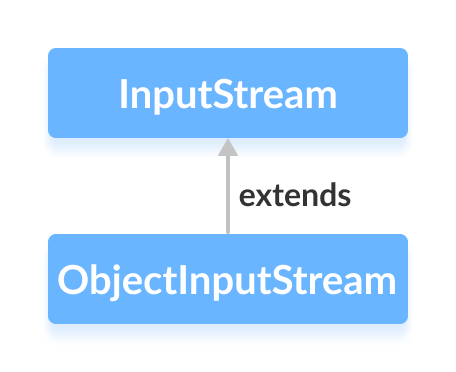java.io包的ObjectInputStream类可用于读取ObjectOutputStream先前编写的对象。
它扩展了InputStream抽象类。

在学习ObjectInputStream类之前,请确保您了解ObjectOutputStream类。
ObjectInputStream的工作
ObjectInputStream主要用于读取由ObjectOutputStream写入的数据。
基本上, ObjectOutputStream将Java对象转换为相应的流。这称为序列化。这些转换后的流可以存储在文件中,也可以通过网络传输。
现在,如果需要读取这些对象,则将使用ObjectInputStream将ObjectInputStream换回相应的对象。这称为反序列化。
创建一个ObjectInputStream
为了创建对象输入流,我们必须首先导入java.io.ObjectInputStream包。导入包后,就可以创建输入流。
// Creates a file input stream linked with the specified file
FileInputStream fileStream = new FileInputStream(String file);
// Creates an object input stream using the file input stream
ObjectInputStream objStream = new ObjectInputStream(fileStream);
在上面的示例中,我们创建了一个名为objStream的对象输入流,该对象输入流与名为fileStream的文件输入流链接在一起。
现在, objStream可用于从文件读取对象。
ObjectInputStream的方法
ObjectInputStream类提供InputStream类中存在的不同方法的实现。
read()方法
-
read()-从输入流中读取一个字节的数据 -
readBoolean()-以布尔形式读取数据 -
readChar()-以字符形式读取数据 -
readInt()-以整数形式读取数据 -
readObject()-从输入流中读取对象
示例1:Java ObjectInputStream
让我们看看如何使用ObjectInputStream类读取由ObjectOutputStream类编写的对象。
import java.io.FileInputStream;
import java.io.FileOutputStream;
import java.io.ObjectInputStream;
import java.io.ObjectOutputStream;
class Main {
public static void main(String[] args) {
int data1 = 5;
String data2 = "This is programiz";
try {
FileOutputStream file = new FileOutputStream("file.txt");
ObjectOutputStream output = new ObjectOutputStream(file);
// Writing to the file using ObjectOutputStream
output.writeInt(data1);
output.writeObject(data2);
FileInputStream fileStream = new FileInputStream("file.txt");
// Creating an object input stream
ObjectInputStream objStream = new ObjectInputStream(fileStream);
//Using the readInt() method
System.out.println("Integer data :" + objStream.readInt());
// Using the readObject() method
System.out.println("String data: " + objStream.readObject());
output.close();
objStream.close();
}
catch (Exception e) {
e.getStackTrace();
}
}
}
输出
Integer data: 5
String data: This is programiz
在上面的示例中,我们使用了readInt()和readObject()方法从文件中读取整数数据和对象数据。
在这里,我们使用了ObjectOutputStream将数据写入文件。然后,我们使用ObjectInputStream从文件中读取数据。
示例2:Java ObjectInputStream
让我们看另一个实际的例子,
import java.io.FileInputStream;
import java.io.FileOutputStream;
import java.io.ObjectInputStream;
import java.io.ObjectOutputStream;
import java.io.Serializable;
class Dog implements Serializable {
String name;
String breed;
public Dog(String name, String breed) {
this.name = name;
this.breed = breed;
}
}
class Main {
public static void main(String[] args) {
// Creates an object of Dog class
Dog dog = new Dog("Tyson", "Labrador");
try {
FileOutputStream file = new FileOutputStream("file.txt");
// Creates an ObjectOutputStream
ObjectOutputStream output = new ObjectOutputStream(file);
// Writes objects to the output stream
output.writeObject(dog);
FileInputStream fileStream = new FileInputStream("file.txt");
// Creates an ObjectInputStream
ObjectInputStream input = new ObjectInputStream(fileStream);
// Reads the objects
Dog newDog = (Dog) input.readObject();
System.out.println("Dog Name: " + newDog.name);
System.out.println("Dog Breed: " + newDog.breed);
output.close();
input.close();
}
catch (Exception e) {
e.getStackTrace();
}
}
}
输出
Dog Name: Tyson
Dog Breed: Labrador
在上面的示例中,我们创建了
- 使用
FileOutputStream命名文件的ObjectOutputStream命名输出 - 使用名为FileStream的
FileInputStream命名为ObjectInputStream输入 - Dog类的对象狗
在这里,我们然后使用对象输出流将对象写入文件。并且,对象输入流从文件中读取对象。
注意 : Dog类实现Serializable接口。这是因为ObjectOutputStream仅将可序列化的对象写入输出流。
ObjectInputStream的其他方法
| Methods | Descriptions |
|---|---|
available() |
returns the available number of bytes in the input stream |
mark() |
marks the position in input stream up to which data has been read |
reset() |
returns the control to the point in the input stream where the mark was set |
skipBytes() |
skips and discards the specified bytes from the input stream |
close() |
closes the object input stream |
要了解更多信息,请访问Java ObjectInputStream(官方Java文档)。